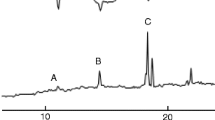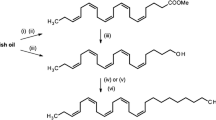Abstract
Solvent extracts of individual pheromone glands were prepared from femaleHelicoverpa assulta (Guenée) at 2-hr intervals throughout the scotophase. The amounts of female sex pheromone components, (Z)-9-hexadecenal, (Z)-11-hexadecenal, (Z)-9-hexadecenyl acetate, and (Z)-11-hexadecenyl acetate, in the extracts were determined by gas chromatographic analysis. Although females called from early scotophase (2 hr) until late scotophase (6 hr) the quantity of extracted pheromone remained high at 8 hr, the end of the scotophase. More than 70% of the pheromone gland extracts contained sex pheromone components regardless of whether the donor females had been called or resting. Pheromone components were absent from gland extracts prepared at the onset of the scotophase. The quantity of (Z)-9-hexadecenal and (Z)-11-hexadecenal increased rapidly to reach a maximum of approximately 260 and 30 ng/female, respectively, that was maintained for up to 8 hr, the duration of the scotophase. The quantity of (Z)-9-hexadecenyl acetate and (Z)-11-hexadecenyl acetate increased continuously during the scotophase to peak at 600 and 30 ng/female, respectively, 8 hr into the scotophase. At the end of scotophase the quantity of all pheromone components decreased significantly.
Similar content being viewed by others
References
Arn, H., Esbjerg, P., Bues, R., Toth, M., Szöcs, G., Guerin, P., andRauscher, S. 1983. Field attraction ofAgrotis segetum males in four European countries to mixtures containing three homologous acetates.J. Chem. Ecol. 9:267–276.
Baker, T. C., andCardé, R. T. 1979. Endogenous and exogenous factors affecting periodicities of female “calling” and male sex pheromone response inGrapholitha molesta (Busck).J. Insect Physiol. 25:943–950.
Cho, J. R., andBoo, K. S. 1988. Behaviour and circadian rhythm of emergence, copulation and oviposition in the oriental tobacco budworm,Heliothis assulta Guenée.Korean J. Appl. Entomol. 27:103–110.
Clearwater, J. R., Foster, S. P., Muggleston, S. J., Dugdale, J. S., andPriesner, E. 1991. Intraspecific variation and interspecific differences in sex pheromones of sibling species inCtenopseustis obliquana complex.J. Chem. Ecol. 17:413–429.
Collins, R. D., andCardé, R. T. 1985. Variation and heritability of aspects of pheromone production in the pink bollworm moth,Pectinophora gossypiella (Lepidoptera: Gelichiidae).Ann. Entomol. Soc. Am. 78:229–234.
Cork, A., Boo, K. S., Dunkelblum, E., Hall, D. R., Jee-Rajunga, K., Kehat, M., Kong, Jie, E., Park, K. C., Tepgidagarm, P., andLiu Xun. 1992. Female sex pheromone of Oriental tobacco budworm,Helicoverpa assulta (Guenée) (Lepidoptera: Noctuidae): Identification and field testing.J. Chem. Ecol. 18:403–418.
Delisle, J., andMcNeil, J. N. 1987. “Calling” behaviour and pheromone titre of the true army-wormPseudaletia unipuncta (Haw.) (Lepidoptera: Noctuidae) under different temperature and photoperiodic conditions.J. Insect Physiol. 33:315–324.
Giebulltowicz, J. M., Webb, R. E., Raina, A. K., andRidgeway, R. L. 1992. Effects of temperature and age on daily changes in pheromone titer in laboratory-reared and wild gypsy moth (Lepidoptera: Lymantriidae).Environ. Entomol. 21:822–826.
Haynes, K. F., andHunt, R. E. 1990. Interpopulational variation in emitted pheromone blend of cabbage looper moth,Trichoplusia ni.J. Chem. Ecol. 16:509–519.
Heath, R. R., McLaughlin, J. R., Proshold, F., andTeal, P. E. A. 1991. Periodicity of female sex pheromone titer and release inHeliothis subflexa andH. virescens (Lepidoptera: Noctuidae).Ann. Entomol. Soc. Am. 84:182–189.
Hunt, R. E., andHaynes, K. F. 1990. Periodicity in the quantity and blend ratios of pheromone components in glands and volatile emissions of mutant and normal cabbage looper moths,Trichoplusia ni.J. Insect Physiol. 36:769–774.
Kamimura, M., andTatsuki, S. 1993. Diel rhythms of “calling” behaviour and pheromone production of oriental tobacco budworm moth,Helicoverpa assulta (Lepidoptera: Noctuidae).J. Chem. Ecol. 19:2953–2963.
Kamimura, M., andTatsuki, S. 1994. Effects of photoperiodic changes on “calling” behaviour and pheromone production in the oriental tobacco budworm moth,Helicoverpa assulta (Lepidoptera: Noctuidae).J. Insect Physiol. 40:731–734.
Kim, Y. K., andBoo, K. S. 1986. Studies on biology and control program of the oriental tobacco budworm,Heliothis assulta, with insect growth regulators and sex pheromone: IV. The circadian rhythm of molting and adult emergence, and the mating behaviour.Agric. Res. Seoul Natl. Univ. 11:1–8.
Kou, R. 1992. “Calling” behavior and pheromone titer in the smaller tea tortrix moth,Adoxophyes sp. (Lepidoptera: Torticidae).J. Chem. Ecol. 18:855–861.
Löfstedt, C. 1990. Population variation and genetic control of pheromone communication systems in moths.Entomol. Exp. Appl. 54:199–218.
Martinez, T., andCamps, F. 1988. Stimulation of sex pheromone production by head extract inSpodoptera littoralis at different times of the photoperiod.Arch. Insect Biochem. Physiol. 9:211–220.
Mbata, G. N., andRamaswamy, S. B. 1990. Rhythmicity of sex pheromone content in femaleHeliothis virescens: Impact of mating.Physiol. Entomol. 15:423–432.
McNeil, J. N. 1991. Behavioural ecology of pheromone-mediated communication in moths and its importance in the use of pheromone traps.Annu. Rev. Entomol. 36:407–430.
Moon, S. C., Hwang, C. Y., andBoo, K. S. 1986. Studies on biology and control program of the oriental tobacco budworm,Heliothis assulta, with insect growth regulators and sex pheromone: V. Morphology of the female sex pheromone gland.Agric. Res. Seoul Natl. Univ. 11:9–12.
Ono, T. 1993. Effect of rearing temperature on pheromone component ratio in potato tuberworm moth,Phthorimaea operculella (Lepidoptera: Gelechiidae).J. Chem. Ecol. 19:71–81.
Ono, T., Chalton, R. E., andCardé, R. T. 1990. Variability in pheromone composition and periodicity of pheromone titer in potato tuberworm moth,Phthorimaea operculella (Lepidoptera: Gelechiidae).J. Chem. Ecol. 16:531–542.
Park, K. C. 1991. Composition and activity of female sex pheromone in the oriental tobacco budworm,Helicoverpa assulta (Guenée). PhD dissertation. Seoul National University, Republic of Korea.
Park, K. C., Cork, A. Boo, K. S., andHall, D. R. 1994. Biological activity of female sex pheromone of the oriental tobacco budworm,Helicoverpa assulta (Guenée) (Lepidoptera: Noctuidae): Electroantennography, wind tunnel observation and field trapping.Korean J. Appl. Entomol. 33:26–32.
Rafaeli, A., andSoroker, V. 1989. Influence of diel rhythm and brain hormone on pheromone production in two lepidopteran species.J. Chem. Ecol. 15:447–455.
Raina, A. K. 1988. Selected factors influencing neurohormonal regulation of sex pheromone production inHeliothis species.J. Chem. Ecol. 14:2063–2069.
Raina, A. K., Klun, J. A., andStadelbacher, E. A. 1986. Diel periodicity and effect of age and mating on female sex pheromone titer inHeliothis zea (Lepidoptera: Noctuidae).Ann. Entomol. Soc. Am. 79:128–131.
Ramaswamy, S. B., Ma, P. W. K., andPitre, H. N. 1988. “Calling” rhythm and pheromone titers inSpodoptera frugiperda (J. E. Smith) (Lep., Noctuidae) from Mississippi and Honduras.J. Appl. Entomol. 106:90–96.
Sugie, H., Tatsuki, S., Nakagaki, S., Rao, C. B. J., andYamamoto, A. 1991. Identification of the sex pheromone of the oriental tobacoo budworm,Heliothis assulta (Guenéee) (Lepidoptera: Noctuidae).Appl. Entomol. Zool. 26:151–153.
Teal, P. E. A., andTumlinson, J. H. 1986. Terminal steps in pheromone biosynthesis byHeliothis virescens andH. zea.J. Chem. Ecol. 12:353–366.
Töth, M., Löfstedt, C., Blair, B. W., Cabello, T., Farag, A. I. Hansson, B. S., Kovalev, B. G., Maini, S., Nesterov, E. A., Pajor, I., Sazonov, A. P., Shamshev, I. V., Subchev, M., andSzöcs, G. 1992. Attraction of male turnip mothsAgrotis segetum (Lepidoptera: Noctuidae) to sex pheromone components and their mixtures at 11 sites in Europe, Asia, and Africa.J. Chem. Ecol. 18:1337–1347.
Author information
Authors and Affiliations
Rights and permissions
About this article
Cite this article
Park, K.C., Cork, A. & Boo, K.S. Intrapopulational changes in sex pheromone composition during scotophase in oriental tobacco budworm,Helicoverpa assulta (Guenée) (Lepidoptera: Noctuidae). J Chem Ecol 22, 1201–1210 (1996). https://doi.org/10.1007/BF02027955
Received:
Accepted:
Issue Date:
DOI: https://doi.org/10.1007/BF02027955




